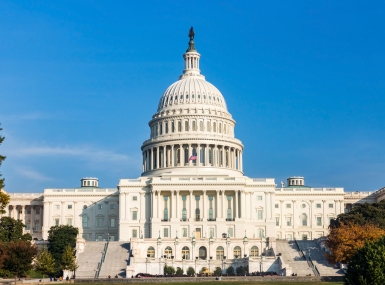U.S. Senate begins action on surface transportation reauthorization
Upcoming Events
Related News

On Tuesday, July 30, the U.S. Senate Environment and Public Works (EPW) Committee unanimously approved a five-year surface transportation reauthorization measure spanning FY 2021 through 2025. The America’s Transportation Infrastructure Act (ATIA) (S. 2302) authorizes $287 billion in funding from the Highway Trust Fund for the nation’s highway surface transportation programs over five years, representing a roughly 27 percent increase over the levels authorized in the previous legislation, the Fixing America’s Surface Transportation (FAST) Act of 2015, which is set to expire in September 2020.
Counties own and operate 45 percent of public roads and almost 40 percent of the National Bridge Inventory, making this legislation and the funding it provides critical for local communities. Below are highlights of key provisions of importance to county governments:
- Maintains the off-system bridge set-aside: ATIA maintains the set-aside under the Surface Transportation Block Grant Program (STBGP) that mandates no less than 15 percent of a state’s STBGP allocation be directed to the repair and rehabilitation of bridges off the federal-aid highways system. This set-aside is critical as it increases the amount and flexibility of STBGP dollars allocated to counties for the improvement of off-system bridges. Counties own and maintain 64 percent of the nation’s 281,184 off-system bridges.
- Streamlines the federal permitting process: The bill codifies certain tenants of the “One Federal Decision” Executive Order, establishing a two-year goal for completion of environmental reviews; a 90-day timeline for related project authorization; a single environmental document and record of decision to be signed by all participating agencies; and an accountability and tracking system to be managed by the U.S. Secretary of Transportation.
- NEW competitive grants for bridges: The legislation authorizes more than $6 billion over five years, including $3.3 billion from the Highway Trust Fund, for a new competitive bridge grant program to address the growing backlog of bridges in poor conditions nationwide. Under this competitive program, states and counties may apply directly for funding through the U.S. Department of Transportation (DOT). Counties own and operate 38 percent of the National Bridge Inventory, over 50 percent of which are considered “structurally deficient” and in need of repair.
- NEW funding and focus for resilient infrastructure: ATIA emphasizes resiliency throughout the bill and expands the eligibility for resilient infrastructure projects to receive federal funding. Resilient measures counties could fund through the bill include relocating roadways to a higher elevation, stabilizing slopes, replacing culverts with bridges or upsizing culverts, tide gates and improving natural features. In addition, the legislation directs specific funding for highway infrastructure that could be affected by flooding, drought, wildfires, rockslides, levee and dam failures and earthquakes. This is particularly important for counties, as 788 counties – or 26 percent – faced at least one major disaster declaration in 2018.
- The bill also provides significant federal investments for communities to build long-lasting, resilient transportation infrastructure by creating the Promoting Resilient Operations for Transformative, Efficient and Cost-saving Transportation (PROTECT) grant program. The PROTECT program would provide $3.9 billion in formula grants and $1 billion in competitive grants, respectively, over five years and would assist areas in recovering from and/or preparing for natural disasters by directing funds to develop resilient infrastructure in vulnerable communities. The PROTECT Program has two components:
- NEW formula grant program: Funded at $786 million per year via the Highway Trust Fund, the formula grant portion of PROTECT will be distributed to states in the same share the state receives based on its core formula apportionments. These funds may be used for construction activities that improve the resiliency of assets to current and future weather events and natural disasters, for strategies that allow for a continuity of operations or rapid recovery of surface transportation systems that serve critical needs following a disaster, including evacuation routes, or to protect coastal infrastructure that is at long-term risk to sea level rise. The federal share is 80 percent; however, funding from other federal sources may be used to cover the remaining 20 percent.
- NEW competitive grant program: Funded at $200 million per year from the Highway Trust Fund, this portion of the grant program is intended to enable communities to assess vulnerabilities and plan infrastructure improvements and emergency response strategies to address community needs. Local governments may apply directly to U.S. DOT for funding in this portion of the PROTECT program.
- NEW programs for transportation safety projects: The legislation increases and expands safety provisions, including designating “leading pedestrian intervals” as an eligible project and allowing states the flexibility to use Highway Safety Improvement Plan (HSIP) funds for educational campaigns on traffic safety and enforcement activities. ATIA creates several new safety grant programs:
- NEW formula safety incentive grant program: ATIA establishes a formula safety incentive program for states funded at $500 million per year from the Highway Trust Fund. Upon receival of the funds, a state must then sub-allocate 65 percent of their share based on population. This incentive program would mandate states use half the funding for highway safety improvement projects, while the remaining half can be used for any project that is eligible under STGBP so long as the state can prove progress is being made to address its vulnerable road safety assessment. If performance data demonstrates a state is making progress in this area, the federal share is equal to 100 percent.
- NEW competitive traffic fatality reduction grant program: ATIA also establishes a fatality reduction program funded at $100 million annually from the Highway Trust Fund. Eligibility is directed toward state and local governments where data shows an adversely high number of fatalities or serious injuries resulting from traffic accidents have occurred. Successful applicants will be states and other units of government who can demonstrate progress in reducing these averages. The grant criteria, which may be funded at up to a 100 percent federal share, is based on the ability of a state or local government to demonstrate one or more of the following:
- Reducing per capita serious injuries and fatalities
- Reducing rates of serious injuries and fatalities per vehicles miles traveled (VMT)
- Having the lowest per capita serious injuries and fatalities
- Having among the lowest per-VMT serious injury and fatality averages
- Innovative safety efforts
- NEW pilot program to reduce wildlife-vehicle collisions: The bill provides $250 million over five years for a new competitive grant program geared toward projects designed to reduce the number of wildlife-vehicle collisions and to improve wildlife habitat connectivity. Local governments may apply directly to U.S. DOT for this grant, and at least 60 percent of funds must go toward projects in rural areas.
- Increases sub-allocation amounts for Transportation Alternatives Program (TAP) Projects: The bill increases the TAP set-aside within the STBGP, as well as its sub-allocation amounts, while also providing smaller communities greater access. TAP was created under the FAST Act and provides funding to projects considered alternative to traditional highway construction. Counties utilize the TAP program for pedestrian and bicycle facilities, trails, safe routes to school projects, community improvements and environmental mitigation, among others.
- NEW language added to give counties the opportunity to receive 100 percent of TAP set-aside funds allocated to states: The legislation includes new language mandating states disperse funds they receive through the TAP set-aside with an opportunity to “allocate up to 100 percent of the funds referred to counties and other local transportation entities.” This provision will give counties the opportunity to receive more federal funding for specific infrastructure projects.
- Increases funding for the Nationally Significant Freight and Highway Projects Program: The Nationally Significant Freight and Highway Projects Program, or INFRA, is increased by 22 percent under ATIA, with $5.5 billion provided over five years. In general, INFRA provides federal funding for transportation infrastructure projects, which counties use to repair and rehabilitate America’s highways and bridges. However, the legislation also sets aside $150 million for a pilot program that would prioritize projects for which states and local governments are willing and able to contribute greater amounts of funds to the non-federal match.
- Increases investments in tribal and federal lands transportation programs: The bill includes $2.9 billion for the Tribal Transportation Program and $2.1 billion for the Federal Lands Transportation Program over five years. Additionally, the bill sets aside $250 million over five years for the construction and rehabilitation of nationally significant projects on federal and tribal lands. This is important for the 62 percent of counties that have federal public lands within our jurisdictions.
- NEW environmental provisions to reduce motor vehicle carbon emissions and road congestion: The bill includes several new environmental provisions that will further assist counties in providing a healthy and safe environment for residents. The legislation includes $3.8 billion over five years in formula and competitive grants to reduce on-road motor vehicle carbon emissions, along with truck emissions at port facilities. In addition, the bill provides $200 million in competitive grants to relieve congestion in major metropolitan areas. Lastly, ATIA reauthorizes the Diesel Emissions reduction Act (DERA) and directs the U.S. Comptroller General to evaluate the Congestion Mitigation and Air Quality Improvement Act
The timing remains unclear on when the remaining three U.S. Senate committees of jurisdiction over surface transportation will act. The rail and transit titles will need to be added to the legislation by the U.S. Senate Committee on Commerce and the U.S. Senate Committee on Banking, respectively. The Senate Finance Committee will also have to produce a “pay for” to cover the bill’s transfers from the general fund, in addition to addressing the impending insolvency of the Highway Trust Fund that is predicted to be bankrupt by 2021. The Senate Finance Committee must find at least $80 billion over five years in order to fund the gap between current projected dedicated revenues and spending levels prescribed in the EPW bill.
The Senate Environment and Public Works Committee marked up its iteration of the bill, outlined here, and it was unanimously approved by the committee. The U.S. House Committee on Transportation and Infrastructure, in conjunction with the U.S. House Committee on Ways and Means (who is also tasked with producing a “pay for”), will develop their own version of the surface transportation reauthorization, likely leading to an eventual conference between the two bills where differences are negotiated.
Key county priorities for any surface transportation reauthorization or comprehensive infrastructure package include:
- Establish funding certainty through a long-term surface transportation reauthorization
- Promote long-term solvency of the Highway Trust Fund
- Provide direct funding to counties and increase local decision-making authority
- Maintain and increase the set-aside for off-system bridges
- Streamline the federal permitting process
The chart accompanying this document outlines key county priorities that would be impacted by EPW’s legislation, as well as how these priorities compare today under the current surface transportation authorization known as the FAST Act.

Attachments
Related News

U.S. House of Representatives passes SPEED Act and other permitting reform bills
On December 18, the U.S. House of Representatives passed the SPEED Act (H.R. 4776). The SPEED Act would strengthen county involvement in decision-making and make needed commonsense reforms to the federal environmental review process.

Counties and Railroads: Shared Priorities for the Next Surface Transportation Bill
County leaders from across the country have a vital opportunity to ensure their infrastructure priorities are front and center.

House lawmakers introduce bipartisan legislation to support World Cup local transportation needs
On December 2, U.S. Reps. Rick Larsen (D-Wash.-02) and Burgess Owens (R-Utah-04) introduced the Transportation Assistance for Olympic and World Cup Cities Act (H.R.6348), a bipartisan effort to strengthen local transportation systems in communities preparing to host major international sporting events